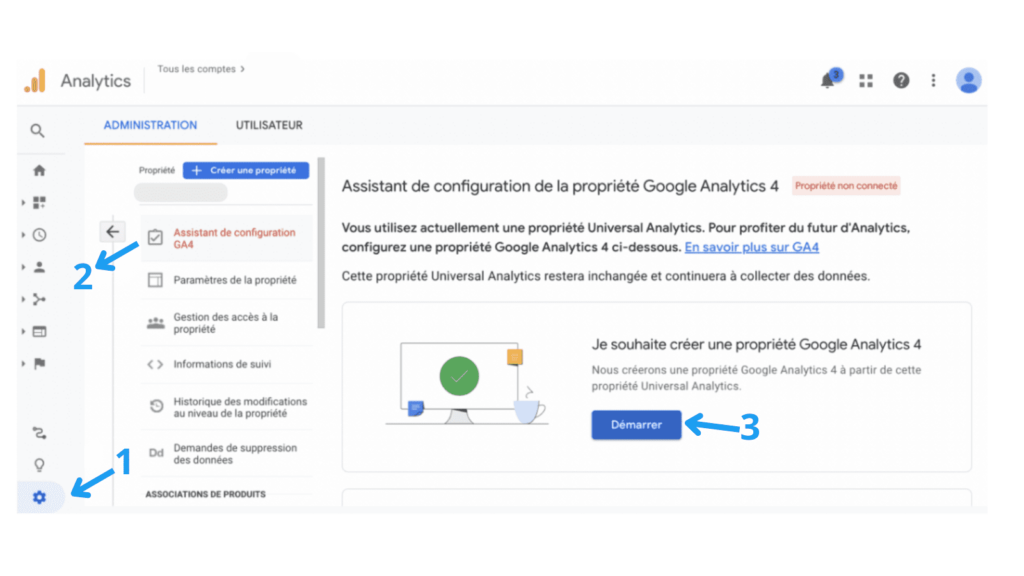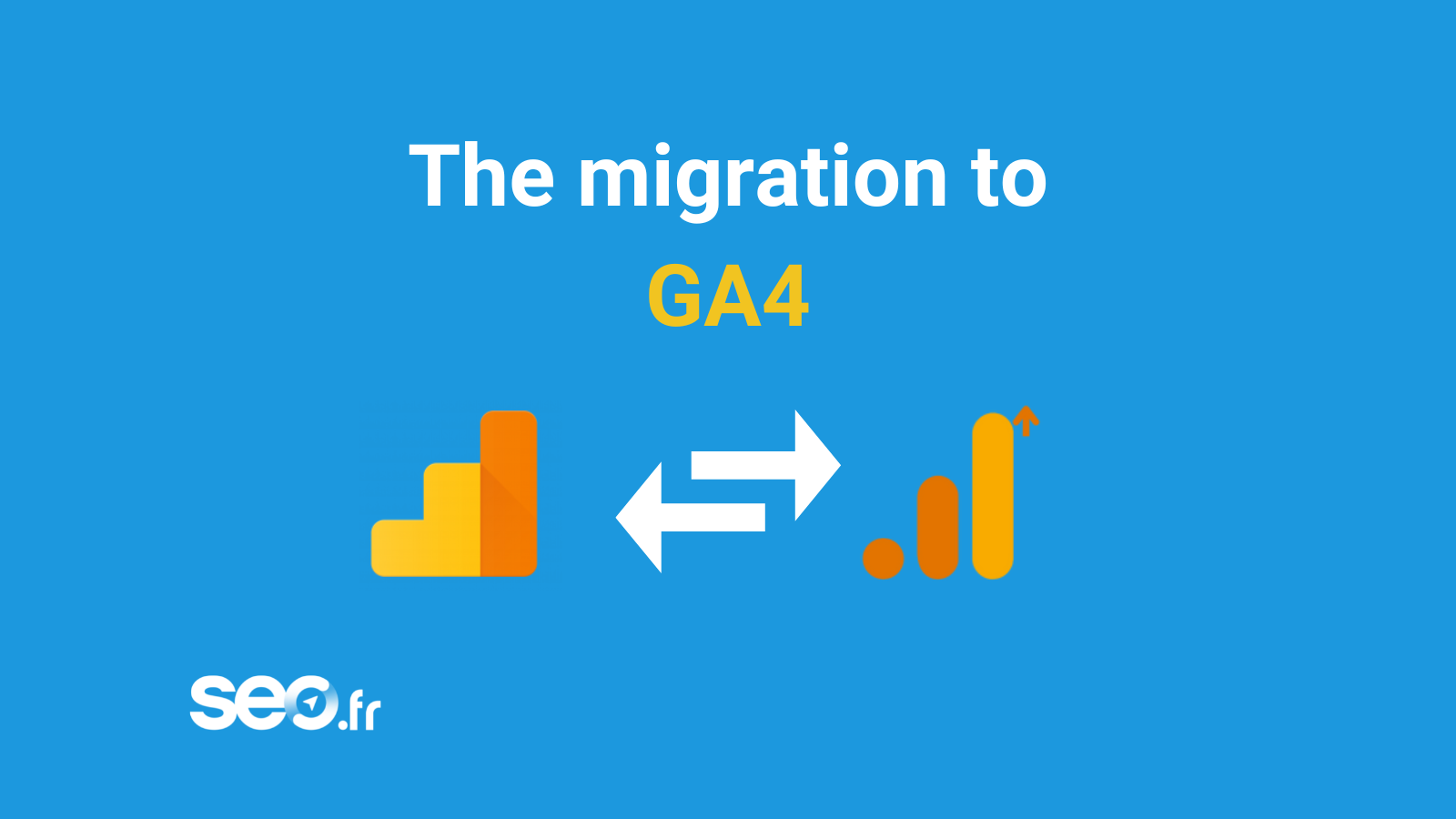Do you know why and how to successfully migrate to GA4? It’s easy. And in 7 steps you can install your tool and learn how to use it. If you are a webmarketing and web analytics professional, you are probably used to using Universal Analystics to measure your advertising campaigns or track your website traffic. It comes in handy. However, this Google tool will soon be out of date. You will have to rely on the new version of Google Analytics. How to migrate to GA4 and use the audience measurement tool? Find out now.
What is Google Analytics? What role does the tool play?
Google Analytics (GA) is one of Google’s free tools and is essential for measuring the digital performance of websites. It is a SaaS solution that can be accessed by site administrators from a browser. This easy-to-use analytical tool helps you collect data on your page traffic.
You can use it to determine the behaviour of visitors to a site. Know your conversion rate thanks to relevant statistics and reports, etc. However, this web analytics platform now has a new version. The new version of Google Analytics brings significant changes to data analysis. If you are a web marketing or web analytics professional, you should prepare for the GA4 migration and take a GA4 training course to get the hang of the tool.

Why is it mandatory to migrate to GA4 now?
Upgrading to Google Analytics 4 is necessary if you want to continue using the new version of Google Analytics. What is Google Analytics 4 (GA4)? It is a more powerful audience measurement tool than Universal Analytics. This new version of GA dates back to October 2020 and features key metrics and site performance. According to information from Google, GA4 heralds the end of Universal Analytics (GA3).
As of 1 July 2023, the new version of Google Analytics will remain the only option available. However, historical data from Universal Analytics will still be available (until 31 December). After that, it will be deleted forever. As you can see, migrating to GA4 is the ultimate solution that allows you to continue measuring the performance of your websites. You should therefore take steps to get to grips with the workings of your analytical tool right away.
What new features does Google Analytics 4 bring to companies today?
No one is unaware of this. Large companies like Google are not standing still. On the contrary, they are adapting and creating even more efficient and innovative tools. This is the case with Google Analytics 4. This tool brings some changes that you should be aware of. If you are already used to the way GA3 works, you will appreciate GA4. The Google Analytics 4 migration:
- Allows for privacy as well as sustainability of collected data and targets cookies less.
- The tool uses artificial intelligence. In doing so, it presents insights relevant to the customer journey across platforms and devices. The GA4 migration also provides you with additional data based on the performance of the traffic accessing your page.
- GA4 supports better integration of the analytics tool with your Google Adwords account. This allows you to analyse and improve the performance of your advertising campaigns. As far as SEO is concerned, the platform helps you choose the right keywords to optimise your natural referencing. This increases your marketing ROI.
- The switch to GA4 allows you to track events in real time thanks to the Google Tag Manager function. You can, for example, detect the number of unique visitors, the number of views on the pages of your site, etc. Reports and dashboard are automated and easy to use
SEO training?
Sylvain is here for you
16 years’ expertise in digital marketing

What are the main benefits of the new version of Google Analytics?
GA4 has many interesting points in terms of benefits. If you are looking to build the pillars of good monitoring, you will benefit from moving to GA4. First of all, you benefit from a better understanding of your audiences. The new version of Analytics offers users a tool that facilitates audience segmentation. It is more flexible and accurate than Universal. The GA4 migration therefore helps you sharpen your targeting to better achieve your conversion goals.
Then, when you perform the GA4 migration, you receive a combination of web, mobile and application data. Your analytics tool shows you the different stages of the customer path. From acquisition through engagement, monetisation and retention, you explore your funnel in detail.
You benefit from cross-device tracking. You get more visibility on visitor behaviour and activities on various platforms. You can measure the effectiveness of your digital strategy or advertising campaigns. GA4 allows you to improve your marketing actions. Finally, thanks to the switch to GA4, you have the ability to track various events related to your web marketing objective. Whether it is the :
- Customer generation;
- Online sales;
- Consumption of educational or tutorial content.
You get all the custom statistics and more analysis with Google Analytics 4. So, are you ready to export your data to GA4? Good. It’s time to do the GA4 migration.
How does the migration from UA to GA4 work?
In simple terms, to move from Universal Analytics to Google Analytics 4, it requires the creation of a new GA4 property. Before you move on to the actual GA4 migration, you need to know how Analytics tracking is done on your pages. This is simple. Right click and display the source code of a page. Now run the CTRL+F command and look for the analytics.js or gtag.js tags. If you are using Google Tag Manager, you can skip all these checks.
This tool makes it easy for you to manage tags and enables fast and efficient updating of tracking codes. Are you ready to move to GA4 from a Universal Analytics property?
Explore the essential steps to successfully migrate to Google Analytics 4
- To start the migration process, click on “administration”. It is located at the very bottom of the screen on the left.
- Then go to the account column. Make sure the account you choose is the right one.
- Then go to the property column. Choose Universal Analytics. This is the data collection tool you use on your website before the GA4 migration.
- Enter the property column and click on the first available option. This is the GA4 Setup Wizard. After these steps of the GA4 migration, you will receive a message. If it tells you that you cannot make any changes and suggests that you contact your account administrator, stop. Indeed, it is essential that your Google Analytics account has at least the editor role to configure this Analytics property.

You may receive a confirmation message. If it says that you are already using a GA4 property, then leave the rest of the steps. If the message instead tells you that you are currently using a Universal Analytics property, continue the process.
- If you wish to use the new version of your analysis tool, continue the migration process. Click on the start button. This will start the creation of a GA4 property.
- Then proceed to activate the data collection on your site. At this stage, pay attention to the tags. Make sure you insert the code: stag.js.
- Press the final button and create a Google Analytics 4 property.

Would you like to find out what type of content your audience likes and which social media they prefer? Take our Google Analytics training today and learn how to use relevant data for better targeting.









